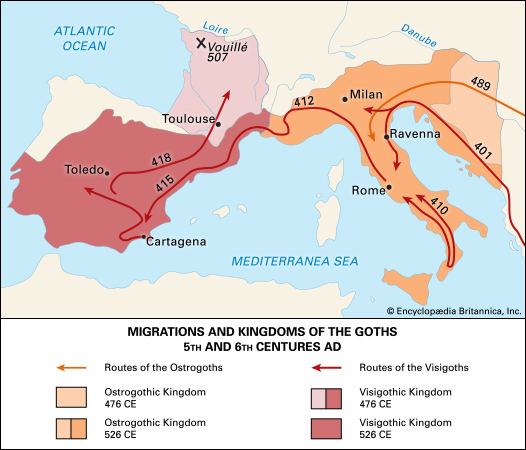King Alaric I was succeeded by his son or cousin Ataulf (410-415). He led his people out of Italy and settled in Gaul, where he made Narbonne his capital after he captured the town in 413. He married Placidia in 414. to obtain legitimacy, without the formal approval of the emperor. Since legitimacy was not granted, Ataulf supported Attalus Priscus, a Roman usurper, Honorius was furious and sent his best commander Constantius against Ataulf. The Visigoths were defeated by Constantius and had to retreat over the Pyrenees, where they would wage war on the Vandals. Ataulf was slain in the battle for Barca (Barcelona today). There is a possibility that he was a victim of a conspiracy of the aristocracy.
Wallia (415-418)
Ataulf was succeeded by his brother Wallia. He led a policy of reconciliation. Placidia was ransomed back to the Romans and they delivered grain to Wallia in return. He waged war on the Vandals and the Suebi as a Roman ally. The emperor granted him the right to settle in southern Gaul (Aquitania) for his services. Their capital was Tolosa (Toulouse). This was the nucleus of the Kingdom of Tolosa that would be formed in 419.
Theodoric I (418 – 451)
Theodoric continued with the policies of Wallia. He was supporting Rome, but also consolidating his rule in Gaul. Using the weakness of the central Roman government for his own gains, he ceased in being a common Roman soldier and became the ruler of a whole Roman province. He confiscated two thirds of Gaul land in Aquitania itself, and the undistributed lands and forests were granted to the Visigoths and the local Roman population. The Roman population had to pay taxes to the state, while the Visigoths were freed from this obligation. Theodoric cooperated with the Roman governors of Gaul when it was in his own interest. In 451 Theodoric fought in the battle of the Catalaunian plains alongside Roman, Burgundian and Frankish forces against the Huns who were led by Attila. There was no decisive victory on either sides but Theodoric was slain during the battle.
Theodoric II (451 – 466)
The sovereignty of the western Roman emperor was formally accepted by Theodoric II, nevertheless, he continued with the conquest of Roman territory. He was especially interested in the Iberian peninsula. After the defeat of the Suebi in Galicia in 456, he became the ruler of that particular region of the Iberian peninsula. His attempt to break through to the northern part of Galicia in 463 failed, due to his defeat in the battle of Aurelianum (Orleans), by the magister militum per Galliam Aegidius. The border remained on the Loire river. Theodoric was killed by his brother Euric in 466.
Euric (466 – 484)
Euric faced a new challenge after his ascension to the throne; he was attacked by the forces of the western Roman emperor Anthemius. But the Roman army was defeated by Euric somewhere on the Rhone River, and a special relationship was maintained with the Burgundians from that time on, since the emperor hoped that they would assist in the war against the Visigoths. Euric campaigned against northern Gaul, like his predecessors, but he was not successful (470), so he turned to conquer the last strongholds of the Roman population instead.



One of these was the Auvergne region, with the administrative center of Auvergnat (Clermont-Ferrand). The bishop of the town, Sidonius Apollinaris, one of the last Roman poets, defended the town for four years. But the town had to surrender in 475, since the Roman emperor Julius Nepos approved all of Euric’s conquests in Gaul and on the Iberian peninsula. Sidonius protested but he was incarcerated by Euric. Soon the Visigoth king realized that they were outnumbered by the Roman population, so he turned to a policy of reconciliation instead. He freed Sidonius and reinstated him as the bishop, and named Leo of Narbonne, a Roman scholar, as his advisor. Euric compiled the Codex Euricianus (between 470 and 480); but the disparity between the Romans and Visigoths was not bridged by this code of law.
Alaric II (484 – 507)
During the reign of Alaric the second, the Frankish king Clovis (481-511) enjoyed greater support with the Catholic church, and among the Roman clergy and people, than the Visigoths who were Arian Christians. Alaric compiled the Lex Romana Wisigothorum or Breviarum Alarici with the goal to gain the support of the Roman population. This was a shortened compilation of the codex from 338, which was codified in the eastern Roman Empire under Theodosius the second, and some other codes of Roman law. This code of law guarantied absolute personal and legal freedom to the Roman population. Alaric was reluctant in the war against the Franks, the Franks used this to their advantage; they defeated the isolated Burgundians and then advanced to the shores of the Loire River.
The decisive battle against the Franks was fought at Vouillé in 507. The Visigoths were crushed and Alaric was slain. The Visigoths were in disarray after the death of Alaric. Clovis used this to his advantage and conquered all of Visigoths Gaul from 507 to 510, only Provence and Septimania remained under Visigoth rule. The Visigoths allied with the great Ostrogoth king Theodoric (493 – 526). The main purpose of this alliance was to keep the remaining territories safe from the Franks, and the Visigoths granted Provence to the Ostrogoths. The focus of the Visigoths moved from Gaul to the Iberian peninsula. Arianism was denounced by the Catholic Church in the decree from 511, which led to the almost complete extinction of the Goths in Gaul.
